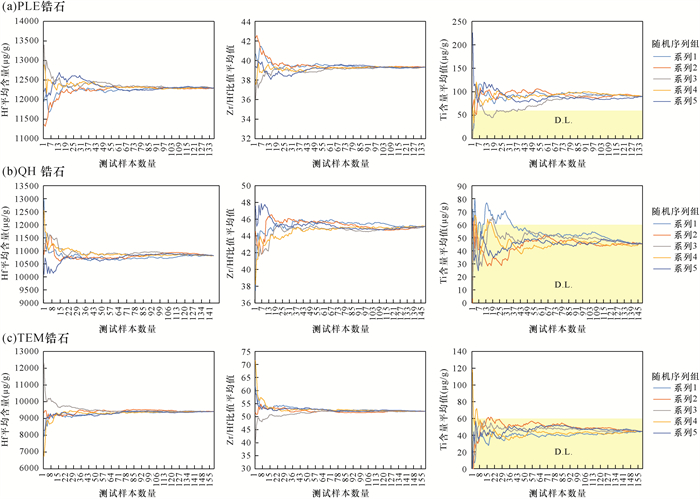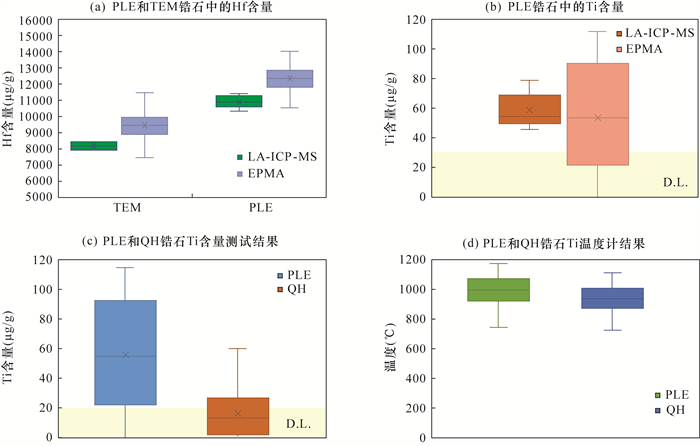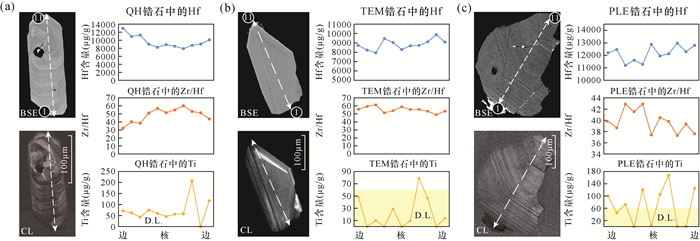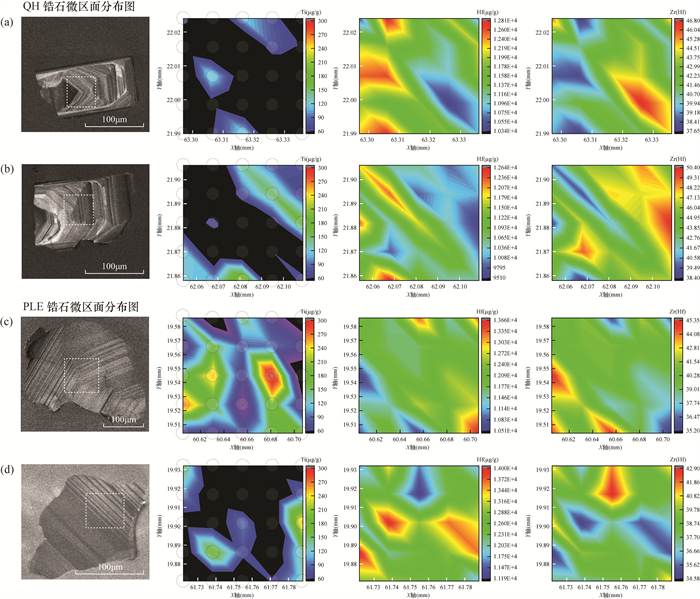Electron Probe Microanalysis of Hf and Ti in Zircon: Significance and Advantage
-
摘要:
锆石是一种重要的定年矿物,其微量元素地球化学行为是解释锆石年龄地质意义的重要依据。锆石微量元素分析一般采用的是在大束斑条件下(10~50μm)的质谱仪测试方法,其结果反映的是在该束斑范围内,元素的平均含量信息。相比之下,电子探针显微分析可以在极小微区范围内(< 5μm)进行元素的定量分析,更能有效地揭示元素的地球化学行为,可作为研究锆石微量元素的重要技术补充。本文以锆石定年中常用标准锆石(TEMORA、Qinghu和Plešovice)作为研究对象,在20kV加速电压、50~300nA轰击电流以及2~5μm束斑条件下,对其中的Hf和Ti进行了定量分析,包括常规的点和线分析(Point/Line Analysis)以及网格分析(Grid Analysis),并以此为基础进行了线性拟合并建模,对元素的面分布情况进行了探讨。在较长的计数时间条件下(300s),本文得到了20μg/g(1σ)的Ti含量检测限。实验结果表明:锆石中的Zr与Hf之间具有负相关性,反映了两者的类质同象替代;其次,在概率统计方面,电子探针Hf和Ti的定量分析结果明显高于LA-ICP-MS方法,反映了其在更小微区下的含量信息以及地球化学行为,须在诸如(锆石)Ti温度计的应用中特别注意。再者,测试所用标准锆石样品的Hf含量(和Zr/Hf比值)在微区下具有环带分布特征,表现为从核部到边部具有升高(降低)的趋势,这与锆石结晶生长过程中的熔体分异程度有关。另一方面,标准锆石样品中的Ti并未表现出类似Hf的分布特征,且Hf(和Zr/Hf比值)与Ti含量之间也没有发现明显的相关性。因此,对于前人提出的Hf具有类似Ti一样的温度计指示功能的观点仍有待进一步探讨。
Abstract:BACKGROUND Zircon is an important refractory mineral that is ubiquitous in most magmatic, metamorphic and sedimentary rocks. It can provide robust U-Pb age(s) for most geologic processes. The trace elements in zircon are of great importance in the interpretation of zircon U-Pb age and relevant geological significance. Commonly, the trace elements abundance in zircon is analyzed by mass spectrometry methods, such as laser ablation inductively coupled plasma-mass spectrometry (LA-ICP-MS), sensitive high-resolution ion microprobe (SHRIMP) and others, which usually require a large spot diameter (10-50μm). Electron probe micro-analyzer (EPMA) is capable of conducting elemental quantitative analyses at micro scales (< 5μm) with relatively high spatial resolution and analytical accuracy/precision. Under appropriate analytical condition settings, the detection limit (D.L.) and analytical uncertainty (standard deviation) of EPMA can be comparable to other high-sensitive methods (e.g. LA-ICP-MS) with only a small difference of one order of magnitude. Besides, EPMA is an accessible instrument in most facilities and is much cheaper and efficient than other techniques. Hafnium is an important trace element in zircon that often substitutes the zirconium ion, since they possess almost the same effective ionic radius in the eightfold coordination, and the zircon has a complete solid solution with the hafnon (HfSiO4). The Hf abundance in zircon is of importance in the zircon U-Pb age interpretation, and so is the Zr/Hf ratio—it commonly relates with magmatic differentiation: the higher Hf or lower Zr/Hf ratio domain is indicative of zircon growth from a more fractionated melt. Besides, the Hf-related geochemistry is also informative of certain tectonic settings, in which zircon formed. Titanium is an important temperature sensor in zircon that can be utilized in the crystallization temperature estimate. The Ti cation prefers to substitute Si in the four-fold coordination instead of replacing the eightfold Zr in the zircon lattice. Currently, the Ti-in-zircon thermometer has been widely used in studies of magmatic and metamorphic rocks, although certain discrepancy may occur compared to other approaches in temperature estimate. Moreover, some researchers reported a negative correlation between Ti and Hf contents in the igneous zircons and thus argued for a potential Hf-related temperature sensor similar to the Ti thermometry.
OBJECTIVES This work investigates the standard zircons conventionally utilized in U-Pb dating: TEMORA (TEM) and Qinghu (QH) zircons of plutonic origin and Plešovice (PLE) zircon of ultrahigh-temperature metamorphic origin. They were provided by the Beijing SHRIMP center (TEM) and Ion Probe Facility Institute of Geology and Geophysics CAS (QH and PLE) as polished epoxy resins targets. Suitable analytical conditions are designed on those standard zircons based on conditional analyses in order to acquire accurate and reliable Hf and Ti contents in zircon.
METHODS EPMA model of JEOL JAX-8100 equipped with four wavelength dispersive spectrometers (WDS) was utilized at Peking University. The standard materials for Zr, Si, Ti and Hf quantification were zircon (Zr, Si), rutile (Ti) and pure metal Hf from the national standard samples collection. Based on the results in the conditional analyses, two separate experiments (Exp-Ⅰ and Exp-Ⅱ) with nuanced analytical conditions were designed at 20kV accelerating voltage. In Exp-Ⅰ measurement, the current beam was set at 50nA and the counting time was adjusted to 100s for Ti and 10s for the rest; Hf (Lα) was measured by a LIF crystal in the high-resolution H type spectrometer (LIFH), Zr (Lα) and Si (Kα) were measured by TAP crystals in two separate spectrometers, and Ti (Kα) was measured by a PET crystal. In Exp-Ⅱ measurement, the current beam was set at 300nA, the counting time for Ti was adjusted to 300s and a PET crystal in the high-resolution H type spectrometer (PETH) was utilized; to avoid possible dead time effects in measuring Zr and Hf, EPMA CAL function was performed with fixed Zr and Hf contents using their average values obtained in Exp-Ⅰ. The background values were selected empirically in the conditional analyses. In both experiments, the spectrometer's pulse height analyzer (PHA) was set in differentiation mode (Dif) with empirical HV values in order to filter the high order X-ray signals of Hf and Zr that might potentially interfere with the measured characteristic X-ray spectra of Ti (Kα). As monitors, standard materials of Zr-free rutile and Ti-free zircon were also analyzed at the end of each measurement. In all, the detection limit for Ti was 60μg/g with relatively higher uncertainties and 20μg/g with moderate-low standard deviation errors in Exp-Ⅰ and Exp-Ⅱ, respectively.
RESULTS In Exp-Ⅰ measurement, a negative correlation is observed between Zr and Hf that corresponds with the isomorphic substitution of Zr and Hf in zircon. The Hf abundance in TEM standard zircon is relatively lower than that in PLE and QH standard zircons. However, there is no obvious correlation, neither negative nor positive, between Hf and Ti and is observed in all analyzed standard zircons. Generally, the Hf content in PLE, QH and TEM standard zircons decreases successively, as does the Zr/Hf ratio; while the Ti content is mostly either close to or below the detection limit (60μg/g) that requires Exp-Ⅱ to re-examine further.
Note, compared to other high precision techniques such as LA-ICP-MS, the content of Hf obtained by EPMA is about 10% higher in general and on average, despite a relatively wider variation range. The content of Ti acquired in Exp-Ⅱ by EPMA is quite comparable in the average with the LA-ICP-MS analyses, but in general, the EPMA analyses for Ti fluctuate greatly, similarly to the case of Hf analyses (by EPMA): this perhaps relates to the different order of magnitude of presence for each element (Hf vs. Ti) in zircon. Nevertheless, in general, both Hf and Ti analyses obtained by EPMA show relatively higher abundances in smaller spot analytical conditions, compared to the LA-ICP-MS measurement with larger spot: the latter method de facto measures an approximate average elemental concentration in the spot domain (e.g.32μm), while EPMA measures elements in a much smaller spot (2μm); it also explains the broad variation of EPMA analyses for both elements, since they perhaps distribute unevenly in zircon. To be noted, the Ti content obtained by EPMA indicates a much higher and expectable (Ti-) temperature that seems to best match the actual peak temperature attainment of parent rocks, derived by alternative thermometric approaches, while the conventional LA-ICP-MS analyses often yielded somewhat underestimated Ti-in-zircon temperatures. This is probably a potential key factor that explains the mismatch of Ti-temperature, derived from LA-ICP-MS analyses, with other methodological outcomes, particularly in the studies of ultrahigh-temperature metamorphic rocks: the peak metamorphic temperature inferred from pseudosection calculation or else is often higher than the zircon Ti temperature in practice.
In the line analysis (Exp-Ⅰ), a pronounced zonation of Hf content (increase) and Zr/Hf ratio (decline) is noticed from core to rim in the standard zircons, along their oscillatory annulus under cathodoluminescence, although it remains ambiguous for Ti because of its lower detection limit and poor reliability. The Hf and Zr/Hf zonation in zircon corresponds well with the zircon crystallization from magmatic melt and may provide an implication for melt presence in a relatively high temperature condition. Thus, such a pattern of Hf and Zr/Hf in zircon is possibly also applicable in the high temperature metamorphism that could help to identify the zircon (over)growth environment.
In the grid analysis (Exp-Ⅰ), several small domains of 40μm×40μm and 60μm×60μm sizes were selected, and the move step at 10-15μm and probe diameter of 5μm were adjusted appropriately. The measurement outcomes were then processed by the software OriginPro (ver. 2020b) in linear calculation mode and were plotted in colored contours to simulate conventional map scan results. The built elemental maps of those small domains show that there is no apparent correlation between Ti and Hf or Zr/Hf: it is in accordance with the above conclusions derived from statistic evaluation and line analyses. Nevertheless, PLE standard zircon seems to possess higher Ti content than the others in general, as being revealed above. Also, there is no obvious correlation between the Hf-Ti distribution in zircon and its oscillatory texture under electron or cathodoluminescence imaging, which commonly relate to other trace elements such as U, Th and REE.
CONCLUSIONS In this work a reliable EPMA method for the quantitative analyses of Hf and Ti in zircon is established. Exp-Ⅰ provides a reliable Hf measurement in zircon, while Exp-Ⅱ provides a lower detection limit (20μg/g) and standard deviation for Ti in EPMA analyses that can be utilized further in practice. EPMA analyses with a small probe diameter show a generally higher outcome compared to other large-spot techniques, such as LA-ICP-MS, despite the relatively wide variation range. This could explain why the Ti-in-zircon temperature, acquired by LA-ICP-MS analyses, was often lower than the actual peak temperature attainment inferred by other methods. Thus, EPMA analyses are recommended as an optimal method for elemental quantification in the first place. The Hf content in zircon is indicative of melt presence, from which zircon crystalized; thus, profile (line) analyses for Hf are informative for zircon origin deciphering. In both igneous and high-temperature metamorphic (standard) zircons, there is no obvious correlation between Ti and Hf or Zr/Hf, thus, it remains unclear whether Hf is temperature related as proposed by other researchers.
-
Key words:
- zircon /
- trace element Hf and Ti /
- Zr/Hf ratio /
- electron microprobe analyzer /
- quantitative analyses
-

-
表 1 锆石的电子探针分析条件
Table 1. EPMA analytical conditions for zircon
实验-Ⅰ:加速电压20kV,激发电流50nA 谱仪通道 元素 特征谱线 分光晶体 计数模式 计数时间
(s)背景测量
位置(mm)背景值计数
时间(s)标样 检测限
(1σ, μg/g)标准偏差
(%)1 Ti Kα PET Dif 10 +1/-5 5 金红石 60 4~800 2 Zr Lα TAP Dif 10 +5/-4 5 锆石 220 0.25 3 Hf Lα LIFH Dif 10 ±5 5 铪金属 120 0.25 4 Si Kα TAP Dif 10 ±5 5 锆石 40 3~5 实验-Ⅱ:加速电压20kV,激发电流300nA 谱仪通道 元素 特征谱线 分光晶体 计数模式 计数时间
(s)背景测量
位置(mm)背景值计数
时间(s)标样 检测限
(1σ, μg/g)标准偏差
(%)3 Ti Kα PETH Dif 300 +2.5/-1.5 5 金红石 20 5~100 -
[1] Speer J A. Orthosilicates zircon. Reviews in mineralogy[M]. Washington D C: Mineralogical Society of America, 1980.
[2] Watson E B, Cherniak D J. Oxygen diffusion in zircon[J]. Earth and Planetary Science Letters, 1997, 148: 527-544. doi: 10.1016/S0012-821X(97)00057-5
[3] Harley S L, Kelly N M. Zircon: Tiny but timely[J]. Elements, 2007, 3(1): 13-18. doi: 10.2113/gselements.3.1.13
[4] 吴元保, 郑永飞. 锆石成因矿物学研究及其对U-Pb年龄解释的制约[J]. 科学通报, 2004, 49(16): 1589-1604. doi: 10.3321/j.issn:0023-074X.2004.16.002
Wu Y B, Zheng Y F. Zircon genetic mineralogy constraints on its U-Pb age interpretation[J]. Chinese Science Bulletin, 2004, 49(16): 1589-1604. doi: 10.3321/j.issn:0023-074X.2004.16.002
[5] Cherniak D J, Watson B E. Pb diffusion in zircon[J]. Chemical Geology, 2001, 172: 5-24. doi: 10.1016/S0009-2541(00)00233-3
[6] Hoskin P W O, Schaltegger U. The composition of zircon and igneous and metamorphic petrogenesis[J]. Reviews in Mineralogy and Geochemistry, 2003, 53(1): 27-62. doi: 10.2113/0530027
[7] Cherniak D J, Watson B F. Diffusion in zircon[J]. Review in Mineralogy and Geochemistry, 2003, 53: 113-143. doi: 10.2113/0530113
[8] Watson E B, Harrison T M. Zircon thermometer reveals minimum melting conditions on earliest Earth[J]. Science, 2005, 308: 841-844. doi: 10.1126/science.1110873
[9] Watson E B, Wark D A, Thomas J B. Crystallization thermometers for zircon and rutile[J]. Contributions to Mineralogy and Petrology, 2006, 151: 413-433. doi: 10.1007/s00410-006-0068-5
[10] Ferry J M, Watson E B. New thermodynamic models and revised calibrations for the Ti-in-zircon and Zr-in-rutile thermometers[J]. Contributions to Mineralogy and Petrology, 2007, 154: 429-437. doi: 10.1007/s00410-007-0201-0
[11] 高晓英, 郑永飞. 金红石Zr和锆石Ti含量地质温度计[J]. 岩石学报, 2011, 27(2): 417-432. https://www.cnki.com.cn/Article/CJFDTOTAL-YSXB201102006.htm
Gao X Y, Zheng Y F. On the Zr in rutile and Ti in zircon geothermometers[J]. Acta Petrologica Sinica, 2011, 27(2): 417-432. https://www.cnki.com.cn/Article/CJFDTOTAL-YSXB201102006.htm
[12] Fu B, Page F Z, Cavosie A J, et al. Ti-in-zircon thermometry: Applications and limitations[J]. Contributions to Mineralogy and Petrology, 2008, 156, 197-215. doi: 10.1007/s00410-008-0281-5
[13] Zhang L, Chen R X, Zheng Y F, et al. Geochemical constraints on the protoliths of eclogites and blue schists from North Qilian, northern Xizang[J]. Chemical Geology, 2016, 421: 26-43. doi: 10.1016/j.chemgeo.2015.11.026
[14] Harrison T M, Schmidt A K. High sensitivity mapping of Ti distributions in Hadean zircons[J]. Earth and Planetary Science Letters, 2007, 261: 9-18. doi: 10.1016/j.epsl.2007.05.016
[15] Ferriss E D A, Essene E J, Becker U. Computational study of the effect of pressure on the Ti-in-zircon geothermometer[J]. European Journal of Mineralogy, 2008, 20: 745-755. doi: 10.1127/0935-1221/2008/0020-1860
[16] 蔺梦, 张贵宾, 宋述光, 等. 低温高压榴辉岩锆石Ti温度计的有效性[J]. 地球科学, 2019, 44(12): 4034-4041. https://www.cnki.com.cn/Article/CJFDTOTAL-DQKX201912009.htm
Lin M, Zhang G B, Song S G, et al. The validity of Ti-in-zircon thermometry in low-temperature/high-pressure eclogites[J]. Earth Science, 2019, 44(12): 4034-4041. https://www.cnki.com.cn/Article/CJFDTOTAL-DQKX201912009.htm
[17] Luvizotto G L, Zack T, Meyer H P, et al. Rutile crystals as potential trace element and isotope mineral standards for microanalysis[J]. Chemical Geology, 2009, 261: 346-369. doi: 10.1016/j.chemgeo.2008.04.012
[18] Li X, Zhang L, Wei C, et al. Quartz and orthopyroxene exsolution lamellae in clinopyroxene and the metamorphic P-T path of Belomorian eclogites[J]. Journal of Metamorphic Geology, 2018, 36: 1-22. doi: 10.1111/jmg.12280
[19] Hoskin P W O, Rodgers K A. Raman spectral shift in the isomorphous series (Zr1-xHfx)SiO4[J]. European Journal of Solid State Inorganic Chemistry, 1996, 33: 1111-1121.
[20] Vervoort J D, Kemp A I S. Clarifying the zircon Hf isotope record of crust-mantle evolution[J]. Chemical Geology, 2016, 425: 65-75. doi: 10.1016/j.chemgeo.2016.01.023
[21] Barth A P, Wooden J L. Coupled elemental and isotopic analyses of polygenetic zircons from granitic rocks by ion microprobe, with implications for melt evolution and the sources of granitic magmas[J]. Chemical Geology, 2010, 277: 149-159. doi: 10.1016/j.chemgeo.2010.07.017
[22] Claiborne L L, Miller C F, Walker B A, et al. Tracking magmatic processes through Zr/Hf ratios in rocks and Hf and Ti zoning in zircons: An example from the Spirit Mountain batholith, Nevada[J]. Mineralogical Magazine, 2006, 70: 517-543. doi: 10.1180/0026461067050348
[23] Claiborne L L, Miller C F, Wooden J L. Trace element composition of igneous zircon: A thermal and compositional record of the accumulation and evolution of a large silicic batholith, Spirit Mountain, Nevada[J]. Contributions to Mineralogy and Petrology, 2010, 160: 511-531. doi: 10.1007/s00410-010-0491-5
[24] Compston W, Meyer C. U-Pb geochronology of zircons from lunar braccia 73217 using sensitive high-resolution ion microprobe[J]. Journal of Geophysical Research, 1984, 89(502): 525-534.
[25] 王彦斌, 张拴宏, 赵越, 等. 锆石SHRIMP年龄测定数据处理时系统偏差的避免——标准锆石分段校正的必要性[J]. 岩矿测试, 2006, 25(1): 9-14. doi: 10.15898/j.cnki.11-2131/td.2006.01.003 http://www.ykcs.ac.cn/cn/article/id/ykcs_20060103
Wang Y B, Zhang S H, Zhao Y, et al. Avoidance of systematic bias of SHRIMP zircon U-Pb dating: Necessity of staged calibrations[J]. Rock and Mineral Analysis, 2006, 25(1): 9-14. doi: 10.15898/j.cnki.11-2131/td.2006.01.003 http://www.ykcs.ac.cn/cn/article/id/ykcs_20060103
[26] 刘建辉, 刘敦一, 张玉海, 等. 使用SHRIMP测定锆石铀-铅年龄的选点技巧[J]. 岩矿测试, 2011, 30(3): 265-268. doi: 10.3969/j.issn.0254-5357.2011.03.004 http://www.ykcs.ac.cn/cn/article/id/ykcs_20110303
Liu J H, Liu D Y, Zhang Y H, et al. Techniques for choosing target points during SHRIMP dating of zircon U-Pb ages[J]. Rock and Mineral Analysis, 2011, 30(3): 265-268. doi: 10.3969/j.issn.0254-5357.2011.03.004 http://www.ykcs.ac.cn/cn/article/id/ykcs_20110303
[27] Hoskin P W O. Minor and trace element analysis of natural zircon (ZrSiO4) by SIMS and laser ablation ICPMS: A consideration and comparison of two broadly competitive techniques[J]. Journal of Trace and Microprobe Techniques, 1998, 16(3): 301-326.
[28] Yuan H, Gao S, Dai M, et al. Simultaneous determinations of U-Pb age, Hf isotopes and trace element compositions of zircon by excimer laser-ablation quadrupole and multiple-collector ICP-MS[J]. Chemical Geology, 2008, 247(1-2): 100-118. doi: 10.1016/j.chemgeo.2007.10.003
[29] 肖志斌, 柳小明, 李正辉, 等. 激光剥蚀-电感耦合等离子体质谱准确测定锆石中钛的含量[J]. 岩矿测试, 2012, 31(2): 229-233. http://www.ykcs.ac.cn/cn/article/id/ykcs_20120206
Xiao Z B, Liu X M, Li Z H, et al. Accurate determination of Ti in zircon by laser ablation-inductively coupled plasma-mass spectrometry[J]. Rock and Mineral Analysis, 2012, 31(2): 229-233. http://www.ykcs.ac.cn/cn/article/id/ykcs_20120206
[30] 周剑雄, 毛水和. 电子探针分析[M]. 北京: 地质出版社, 1988.
Zhou J X, Mao S H. Electron microprobe analysis[M]. Beijing: Geological Publishing House, 1988.
[31] 徐萃章. 电子探针分析原理[M]. 北京: 科学出版社, 1990.
Xu C Z. The principle of electron microprobe analysis[M]. Science Press, 1990.
[32] 李小犁. 电子探针微量元素分析的一些思考[J]. 高校地质学报, 2021, 27(3): 306-316. https://www.cnki.com.cn/Article/CJFDTOTAL-GXDX202103007.htm
Li X L. Several perspectives on microprobe trace elements analysis[J]. Geological Journal of China Universities, 2021, 27(3): 306-316. https://www.cnki.com.cn/Article/CJFDTOTAL-GXDX202103007.htm
[33] 李小犁, 张立飞, 魏春景, 等. 俄罗斯白海地区太古代榴辉岩的金红石Zr温度计应用及其地质意义[J]. 岩石学报, 2017, 33(10): 3263-3277. https://www.cnki.com.cn/Article/CJFDTOTAL-YSXB201710018.htm
Li X L, Zhang L F, Wei C J, et al. Application of Zr-in-rutile thermometry and its interpretation on the Archean eclogite from Belomorian Province, Russia[J]. Acta Petrologica Sinica, 2017, 33(10): 3263-3277. https://www.cnki.com.cn/Article/CJFDTOTAL-YSXB201710018.htm
[34] Cui J Q, Yang S Y, Jiang S Y, et al. Improved accuracy for trace element analysis of Al and Ti in quartz by electron probe microanalysis[J]. Microscopy and Microanalysis, 2019, 25: 47-57.
[35] 崔继强, 郭晟彬, 张若曦, 等. 电子探针多道波谱仪同时测试同一个元素的方法: 以石英中Al和Ti含量的测试为例[J]. 高校地质学报, 2021, 27(3): 340-348. https://www.cnki.com.cn/Article/CJFDTOTAL-GXDX202103010.htm
Cui J Q, Guo S B, Zhang R X, et al. EPMA simultaneous determination of an element by multi-spectrometer: A case study of the determination of Al and Ti contents in quartz[J]. Geological Journal of China Universities, 2021, 27(3): 340-348. https://www.cnki.com.cn/Article/CJFDTOTAL-GXDX202103010.htm
[36] Donovan J J, Lowers H A, Rusk B. Improved electron probe microanalysis of trace elements in quartz[J]. American Mineralogist, 2011, 96: 274-282.
[37] Widenbeck M, Alle P, Corfu F, et al. Three natural zircon standards for U-Th-Pb, Lu-Hf, trace-element and REE analyses[J]. Geostandard Newsletter, 1995, 19: 1-23.
[38] Black L P, Kamo S L, Allen C M, et al. TEMORA 1: A new zircon standard for Phanerozoic U-Pb geochronology[J]. Chemical Geology, 2003, 200: 155-170.
[39] Black L P, Kamo S L, Allen C M, et al. Improved 206Pb/238U microprobe geochronology by the monitoring of a trace-element-related matrix effect; SHRIMP, ID-TIMS, ELA-ICP-MS and oxygen isotope documentation for a series of zircon standards[J]. Chemical Geology, 2004, 205: 115-140.
[40] Slama J, Kosler J, Condon D J. et al. Plešovice zircon—A new natural reference material for U-Pb and Hf isotopic microanalysis[J]. Chemical Geology, 2007, 249: 1-35.
[41] 李献华, 唐国强, 龚冰, 等. Qinghu(清湖)锆石: 一个新的U-Pb年龄和O, Hf同位素微区分析工作标样[J]. 科学通报, 2013, 58(20): 1954-1961. https://www.cnki.com.cn/Article/CJFDTOTAL-KXTB201320010.htm
Li X H, Tang G Q, Guo B, et al. Qinghu zircon: A working reference for microbeam analysis of U-Pb age and Hf and O isotopes[J]. Chinese Science Bulletin, 2013, 58(20): 1954-1961. https://www.cnki.com.cn/Article/CJFDTOTAL-KXTB201320010.htm
[42] Corfu F, Hanchar J M, Hoskin P W O, et al. Atlas of zircon textures[J]. Reviews in Mineralogy and Geochemistry, 2003, 53(1): 469-500.
[43] 路凤香, 桑隆康. 岩石学[M]. 北京: 地质出版社, 2001.
Lu F X, Sang L K. Petrology[M]. Beijing: Geological Publishing House, 2001.
[44] Cann J R. Rayleigh fractionation with continuous removal of liquid[J]. Earth and Planetary Science Letters, 1982, 60(1): 114-116.
-



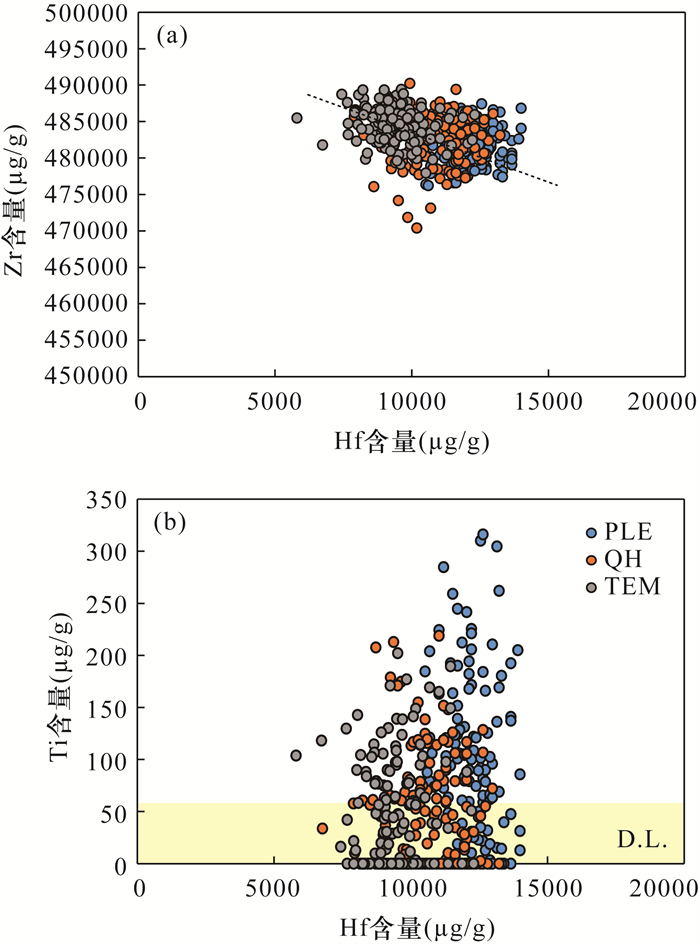
 下载:
下载:
